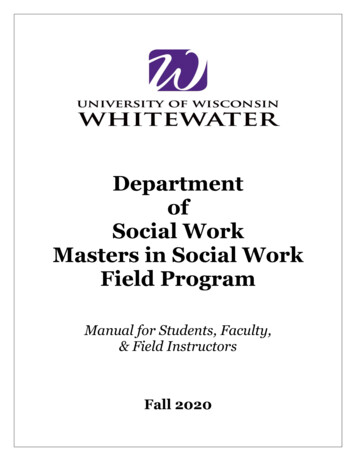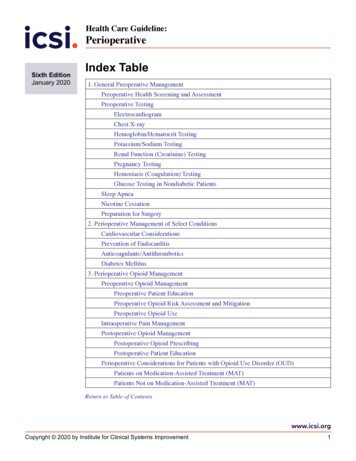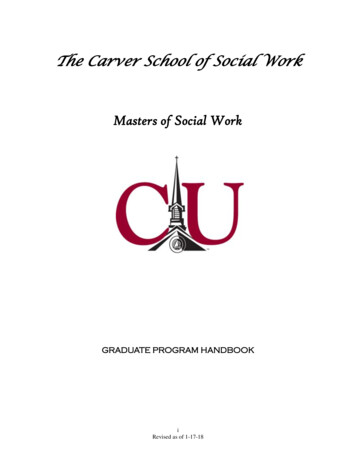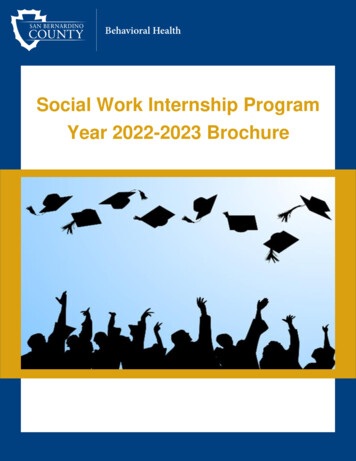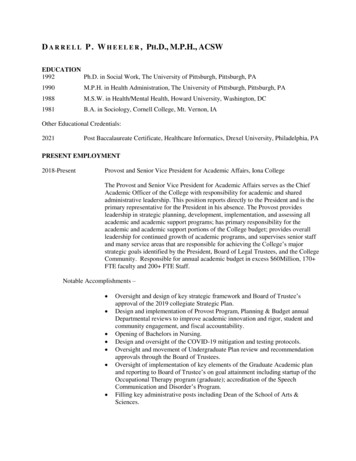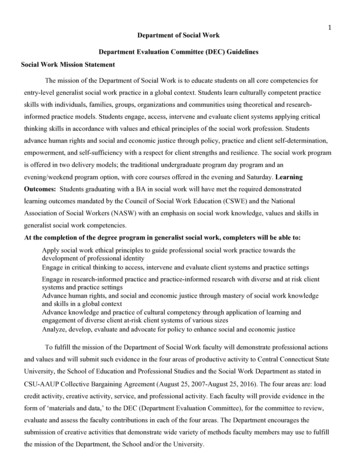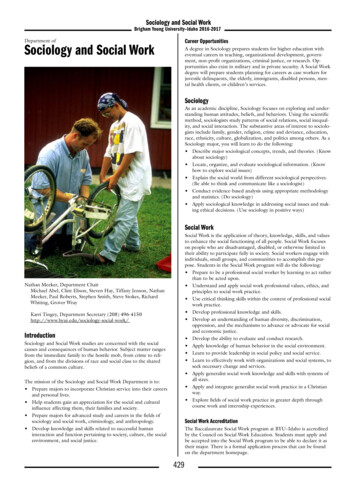
Transcription
Systematic Approach to SocialWork Practice:Working with Clients withTraumatic Brain InjuryMargaret A. Struchen, Ph.D.Research Scientist, Brain Injury Research CenterTIRR Memorial HermannAssistant Professor, Dept. of PM&RBaylor College of MedicineAllison N. Clark, Ph.D.Assistant Professor, Dept. of PM&RBaylor College of MedicineAcknowledgementsSpecial Thanks to those who participated in the conceptualization and review of thisManual: Patti Aldredge, MSSW; Cheryl Amoruso, LMSW, LCDC; Shawn Brossart, LMSW;Deanna Burrell, Ph.D.; Jason Ferguson; Mary John, LMSW, CCM; Patsy Johnson, LMSW;Patrick Leung, Ph.D.; Marie Silva, LMSW-ACP; and Lynne C. Davis, Ph.D. Baylor College of Medicine, 2007This program is sponsored by a grant from the National Institute on Disability and RehabilitationResearch, U.S. Department of Education, for the Rehabilitation Research and Training Center onCommunity Integration of Persons with Traumatic Brain Injury (Grant #: H133B031117) atTIRR Memorial Hermann.
RRTC on Community Integration of Persons with TBIINTRODUCTIONTraumatic brain injury (TBI) is a pervasive public health problem in the UnitedStates, as well as worldwide. Given that the estimated incidence of TBI is 1.4million new injuries per year in the United States,1 with approximately 5.3 millionindividuals living with significant disability as a result of TBI,2 it is very likely thatsocial workers in the healthcare arena will encounter at least one client who hassustained a traumatic brain injury in their work experience. Despite the highincidence of TBI, information to help guide the social worker who may not havehad education or training regarding issues relevant to working with clients withTBI has not been readily available.Specialized services are often available for those who experience TBI throughtrauma centers and neurosurgical intensive care units in major medical hospitals,rehabilitation hospitals with specialized units for brain injury rehabilitation,outpatient comprehensive brain injury rehabilitation programs focused oncommunity re-entry, transitional living centers for persons with brain injury, andcommunity-based brain injury programs. Social workers employed in thesevarious settings will likely become “experts” in working with those with TBI.Training for such individual social workers may happen “on the job,” and throughinservices, seminars, and individual study.While a subset of individuals affected by TBI will receive specialized brain injurycare in one of the settings mentioned above, a great number of individuals willreceive their care after injury in general medical settings, in a generalrehabilitation unit with no special expertise in working with issues related to TBI,in primary care settings, and in social service settings. In these situations, socialwork professionals encountering individuals with TBI will be less likely to haveaccess to training or educational materials that may assist them in the care ofthose with TBI. This manual has been developed to help fill this gap, by serving asa resource to social workers who encounter clients with traumatic brain injury intheir clinical practice. The goal of this educational tool is to assist social workersto feel more comfortable and confident in their clinical interactions with clientswith brain injury, to increase knowledge regarding TBI, to outline skills that areuseful in working with clients with TBI, and to highlight resources that may be ofuse to clients with TBI and their family members. Ultimately, the aim of thistraining tool is to improve the overall quality of care that individuals with TBI willreceive in various healthcare settings.In the initial sections of this manual, general information about TBI andclarification of some terminology is presented. The remainder of the manual hasbeen organized in accordance with a problem-focused model of practice, asoutlined by Compton and Galaway (1989)3 in their classic text “Social WorkProcesses.” It is hoped that this structure will enhance the applicability of thismaterial to your clinical practice.Page 2
Systematic Approach to Social Work Practice:Working with Clients with Traumatic Brain InjuryTABLE OF CONTENTSIntroduction .2General Information: Brain Injury 101—Traumatic Brain Injury FAQs .8What is traumatic brain injury?.8How does the brain become injured?.9What is the difference between head injury and a TBI?.11What is the difference between TBI and acquired brain injury?.12What is the difference between a mild, moderate, and severe traumaticbrain injury?.13What are common sequelae (consequences) of TBI?.16How long will problems last after TBI?.26To what extent is TBI a common health problem?.28In what ways might I be asked to participate in the care of clients withTBI?.28Key Points to Remember 29A Systematic Approach to Social Work Practice for Clients with TBI .30Contact Phase .31Contact: Attitudes .32Contact: Knowledge .33Injury severity . 34Responsiveness . .34Orientation . .36Sensory/motor functioning issues .38Primary language .38Cultural background . .39Page 3
RRTC on Community Integration of Persons with TBITABLE OF CONTENTS (cont.)Page 4Contact: Skills 40Increasing familiarity with terms and scales .40Assessing orientation . .42Applying effective communication strategies. .44Comfort with explaining role .47Key Points to Remember .48Problem Identification, Data Collection, and Assessment Phase .49Problem Identification: Attitudes .50Problem Identification: Knowledge .51Common sequelae (consequences) of TBI .51Need for involvement of family/support system .52Pre-injury roles/functions . .53Pre-injury history .53Client’s current strengths .54Problem Identification: Skills .56Identification of client’s challenges . .56Identification of support system .59Cultural/educational background in communication withclient and support system . .61Awareness of current strengths/limitations .61Key Points to Remember 63
Systematic Approach to Social Work Practice:Working with Clients with Traumatic Brain InjuryTABLE OF CONTENTSCase Planning .64Case Planning: Attitudes .65Case Planning: Knowledge 66Integration of client/family goals with functional status .66Understanding importance of recovery course .67Knowledge of resources .69Case Planning: Skills .70Balance hope with functional status and recovery .70Apply effective communication to address role changes .72Identify/maintain resource list 73Key Points to Remember 74Intervention .75Intervention: Attitudes .76Intervention: Knowledge .77Client Needs: .78Impact of awareness on compliance .78Practical compensatory strategies .79Utilization of strengths to maximize function .87Knowledge of adjunct resources .87Knowledge of coping strategies .88Impact of financial resources/access 89Page 5
RRTC on Community Integration of Persons with TBITABLE OF CONTENTS (cont.)Page 6Support System Needs: .90Impact of caregiving on health/well-being .90Awareness of resources/application processes .91Service Delivery Needs: .92Ways to adapt clinical practice to maximize benefit.92Intervention: Skills .93Balance support with realistic self-appraisal .94Use appropriate strategies to compensate .94Tailor interventions to cultural/educational needs.95Identify resources .95Facilitate use of coping strategies .96Communication regarding financial resources .96Facilitate understanding of treatment goals .97Opportunities for discussing caregiver role .97Strategies for management of caregiver stress 98Facilitate completion of applications for resources.98Assisting understanding and recall . .99Communicate with staff regarding adaptations .100Key Points to Remember .101
Systematic Approach to Social Work Practice:Working with Clients with Traumatic Brain InjuryTABLE OF CONTENTS (cont.)Evaluation .102Evaluation: Attitudes . .103Evaluation: Knowledge . .104Understanding conceptual framework . .104Commonly used outcome measures .107Evaluation: Skills .109Selecting tools for your clinical practice .109Applying systematic approach to evaluation .110Key Points to Remember .111Termination .112Termination: Attitudes .113Termination: Knowledge 113Knowledge of community resources . .114Implementing extended case management approach .114Termination: Skills .115Networking to facilitate referrals .115Developing extended case management .116Key Points to Remember .117Appendix I: Clarification of Issues Regarding Injury Severity . .118Appendix II: Sample Resource List (Houston Metropolitan area) .122Appendix III: References .127SUPPLEMENT: Summary Card of Systematic Approach to Social WorkPractice for Clients with Traumatic Brain Injury . .Back PocketPage 7
RRTC on Community Integration of Persons with TBIGENERAL INFORMATION: BRAIN INJURY 101This section is intended to provide some generalinformation about traumatic brain injury and to helpclarify some of the confusing terminology that you maycome across in your review of medical records and inyour independent reading about brain injury.The following Frequently Asked Questions (FAQs) will tryto address some of the most commonly encounteredterms and general issues. More detailed informationabout assessment and intervention approaches will bepresented in future sections of this manual.TRAUMATIC BRAIN INJURY FAQs: What is a traumatic brain injury (TBI)?A traumatic brain injury is also referred to as a TBI. A TBI occurs when a mechanical force isapplied to the head and affects brain functioning. The mechanical force can consist of a blow to thehead (such as from an assault, a fall, or when an individual strikes his/her head during a motorvehicle accident) or from a rapid acceleration-deceleration event (like a motor vehicle accident). It ispossible for the brain to become injured even if the head has not directly struck or been struck byanother object. The brain can become injured whether or not the skull is fractured. The mostcommon causes of TBI include the following: Falls (28%)Motor vehicle-traffic crashes (20%)Struck by/against (19%)Assaults (11%).1Blasts are a leading cause of TBI for active dutymilitary personnel in war zones.4We know that brain functioning has been disrupted if an individual has a change in their levelof consciousness after injury or in their ability to be alert and/or fully oriented after injury. After a TBI,some people are “knocked out” or lose consciousness. This can be for a short time (seconds tominutes) or for a much longer time (days to weeks). This longer period of time is often referred to asa coma. On the other hand, some people who experience a mild TBI may not lose consciousness atPage 8
Systematic Approach to Social Work Practice:Working with Clients with Traumatic Brain Injuryall. Instead, they may feel dazed, confused, or “out of it” for a period of time. For many people whoexperience a TBI, there may be loss of memory for the events just before and for a period of timeafter the injury. Loss of memory for events preceding the injury is called retrograde amnesia. Theperiod of time when memories are affected after a TBI is called post-traumatic amnesia. How does the brain become injured?Injury to the brain can happen in many different ways. There are two main types of TBI: Closed TBIand Open TBI.Closed TBI happens when the brain is hurt without anything (like a knife, a bullet, or otherobject) going through the skull. Other terms you may encounter for this type of injury includebrain injury due to blunt-force trauma or non-penetrating TBI. There are many ways that thebrain can be injured in a closed TBI. When force is applied to the head, the brain can shake around inside the skull. Thinkof the brain being like jello in a bowl. If you shake the bowl quickly and then stop it, thejello bounces around against the inside of the bowl. Just like jello, the brain canbounce against the inside of the skull. If the head stops quickly after it has beenmoving, the brain can hit the inside of the skull. When this happens, the brain can geta bruise. Sometimes the brain can be bruised both at the point of impact (a coupinjury) and at a point directly opposite to that impact (a contre-coup injury). This isbecause the brain can “bounce” within the skull such that it will bruise both on theside where it has been struck and on the opposite side where the brain has “bounced”back after the impact. When the brain is shaken inside the skull, other injuriescan happen. The brain is made of millions of nerve cellscalled neurons. Each nerve cell has long and thin fiberscalled axons. These axons are important for thetransmission of messages from one neuron to another.These fibers are very small and cannot be seen by thehuman eye. Some of these nerve fibers can be stretchedor broken when the brain is shaken. This stretching andbreaking of axons may be seen throughout the brain andis called diffuse axonal injury. Sometimes a person canhave an injury to the brain, even when the head is not hit by anything. The force of thebrain moving inside of the skull can cause these stretching or tearing injuries to thenerve fibers. If many of these fibers are damaged, the injury can sometimes be seenwith neuroimaging tests, like a CT scan or MRI scan.Page 9
RRTC on Community Integration of Persons with TBI The brain has lots of blood vessels in it, including both arteries and veins. If there issufficient force applied to the head, these blood vessels can tear and bleed. Bleedingwill show up on tests, like a CT scan or MRI scan. A collection of blood in the spacesbetween the meninges (layers of tissue surrounding the brain) and the skull is calledan epidural hematoma. One that occurs between the outer layer of the meninges andthe second layer of meninges is called a subdural hematoma. Blood collection belowthe second layer of meninges is called a subarachnoid hemorrhage. Finally, blood thatcollects within the brain tissue itself is called intracerebral hemorrhage. If there is onlya little bleeding, it will usually stop on its own. The blood vessels will heal, just like anycut on the body heals. If the bleeding is severe, doctors may recommend treatment,like surgery, to remove the blood. Sometimes extra fluid will build up near the hurt brain. This causesswelling or edema. Think of what happens when you hit your arm onsomething. You may see swelling in the injured area. This is because thebody sends extra fluid to the injured body part to protect it and help withhealing. This same thing can happen to the injured part of the brain. If too much pressure builds within the skull due to edema or to theaccumulation of blood, the individual is said to experience intracranialhypertension. This condition can cause additional damage to braintissue if it is unable to be controlled and may even be life-threatening. In addition, after injury many biochemical changes can take place thatcan cause further damage.Open TBI happens when something penetrates through theskull and hurts the brain. Other terms you may encounter forthis type of injury include penetrating TBI. Things like agunshot wound to the head, a stab wound, or a severe skullfracture can cause an open TBI.Page 10 In an open TBI, most of the damage happens to thepart of the brain that was cut or bruised by theobject penetrating the skull. Just like in closed TBI, additional injury can occurdue to bruising, bleeding, or swelling.
Systematic Approach to Social Work Practice:Working with Clients with Traumatic Brain Injury What is the difference between a head injury and a TBI?A head injury happens when a mechanical force is exerted toward an individual’s head. Manythings can cause a head injury. For example, a car accident, a fight, a fall, or other events can allcause a head injury. Most of the time, a head injury does not cause lasting problems. This is because thebrain is well protected. The brain is surrounded by fluid, called cerebral spinal fluid(CSF). This fluid acts as a shock absorber. There are also several coverings around thebrain. These coverings include the hair, the scalp, and the skull. There are also layersof tissue that cover the brain called meninges. These protective layers will often keepthe brain from getting hurt. Often, a bruise, swelling of the scalp, or a cut to the scalpmay be the only injury. Sometimes the force of the blow to the headis greater. The skull can fracture or break.The skull is like a “helmet” that protects thebrain. When the skull breaks, it lessens theforce of the blow. This may help keep thebrain from getting hurt. However,sometimes the force exceeds the skull’sability to protect the brain, and the brainitself can be injured. Given sufficient force,the brain can become injured whether ornot the skull is fractured.When the force that resulted in the head injury affects brain functioning, such as by reducinglevel of consciousness or by causing a period of confusion, the injury is called a traumatic braininjury. Only a subset of head injuries will result in TBI. For example, if you bump your head on the roof of your car, you probably will not injureyour brain. If the only consequence of this injury is a sore head, no brain injury hasoccurred. This is a head injury, but not a traumatic brain injury. However, if your car is struck by another vehicle and you have trouble recalling whathappened over the first 24 hours after the injury, you may have experienced a TBI.Page 11
RRTC on Community Integration of Persons with TBI What is the difference between traumatic brain injury (TBI) andacquired brain injury (ABI)?Increasingly, as one reads news articles, consumer-focused periodicals, and scientificpublications about brain injury, the term “Acquired Brain Injury” or “ABI” has gained prominence. So,what distinguishes a TBI from an ABI?Page 12 Traumatic brain injury (TBI) refers specifically to injuries to the brain that are the resultof mechanical force. As described above, falls, motor vehicle accidents, assaults, andfalling objects may cause a traumatic brain injury. Acquired brain injury (ABI) is a more general term that refers to any acquired (i.e., notdevelopmental) injury to brain tissue. Traumatic brain injury is just one type ofacquired brain injury. All traumatic brain injuries would be considered acquired braininjuries. However, not all acquired brain injuries should be considered traumatic braininjuries. Although not an exhaustive list, other causes of brain injury that would beclassified as acquired brain injuries include: Stroke (or “brain attack”) is when brain cells are damaged or die due tointerruption of blood flow to the brain. There are two main types ofstrokes: 1) blockage of a blood vessel in the brain due to either a clot ora buildup of fatty deposits and cholesterol in the walls of blood vessels;and 2) breakage of a blood vessel in the brain with bleeding from theblood vessel. Cerebral aneurysm is a weak or thin spot on a cerebral blood vesselwall that can break under pressure and result in a bleed orhemorrhagic stroke. Arteriovenous malformation (also known as AVMs) are defects of thecirculatory system that typically involve a collection of blood vesselswith abnormal connections. Such malformations are usually presentfrom birth and can occur in various areas of the body, including thebrain. Typically, AVMs are non-symptomatic. However, a certainpercentage of these cerebral malformations can cause problems suchas headache, seizure, and other neurological symptoms. These occureither through bleeding from the AVM, through blockage of blood flow,or due to pressure effects on surrounding brain tissue. Brain Tumor is a mass or growth of abnormal cells within the brain.These can be benign (noncancerous) or malignant (cancerous), slowgrowing or fast-growing, and can be primary (the first site of cancer) ormetastatic (a second site of cancer that has spread from somewhereelse in the body).
Systematic Approach to Social Work Practice:Working with Clients with Traumatic Brain Injury Brain abscess is an uncommon, but serious or lifethreatening infection. An abscess is a mass of immunecells, pus, and other material due to bacterial or fungalinfection. Cerebral hypoxia occurs when there is a decrease ofoxygen supply to the brain even though there isadequate blood flow. Drowning, strangling, choking, suffocation, cardiac arrest,head trauma, carbon monoxide poisoning, and complications of generalanesthesia can create conditions that can lead to cerebral hypoxia. Brain cells areextremely sensitive to oxygen deprivation and can begin to die within five minutesafter oxygen supply has been cut off. Radiation necrosis is a focal structural lesion that usually occurs at the originaltumor site and is a potential long-term central nervous system (CNS) complicationof radiotherapy or radiosurgery. Radiation necrosis can occur when radiotherapy isused to treat primary CNS tumors, metastatic disease, or head and neckmalignancies. It can occur secondary to any form of radiotherapy modality orregimen.What is the difference between a mild, moderate, and severe traumaticbrain injury?When an injury is referred to as mild, complicated mild, moderate, or severe, we are referringto the initial injury itself – not the eventual outcome that an individual with TBI may experience. Thelevel of severity of the initial injury can be related to many different variables. Such variables includehow much force was involved, how hard the head was struck, how heavy the object was that struckthe head, and how fast the head or object was moving at the time of injury. It is possible that aperson with an initial rating of mild TBI may experience a poor outcome that includes areas ofmoderate to severe difficulty. Likewise, an individual who presents initially with a severe injury mayexperience a very good outcome. However, in general, initial injuries with greater severity will beassociated with poorer outcomes.As soon as healthcare professionals encounter an individual with TBI, an attempt is made tograde the severity of the injury. The level of severity is determined to assist with initial triaging and tohelp with planning treatment. There are several factors that are considered when assessing injuryseverity: Loss of Consciousness (LOC): One thing that the medical team looks at is called loss ofconsciousness. After a head injury, an individual may be “knocked out” or loseconsciousness. The longer this period of unconsciousness, the more severe the injury. Inan acute hospital setting, the medical team will be tracking consciousness on an hourlyand daily basis. Frequently, such tracking is done using a scale called the Glasgow ComaScale (GCS), which is described below.Page 13
RRTC on Community Integration of Persons with TBI Glasgow Coma Scale (GCS):5 The GCS is a scale that is utilized in many hospital settingsthroughout the United States and the world. It was developed to assess the level ofresponsiveness for individuals with TBI. The GCS evaluates three things: eye opening (canthe individual open his/her eyes spontaneously?), motor responses (can the person movewhen asked or when responding to painful stimuli?), and verbal responses (can theperson speak and is the person oriented?). The GCS score can range from 3 to 15. Thehigher the GCS score, the less severe the injury. The lower the GCS score, the more severethe injury. The medical team completes this scale at the scene of the injury if theindividual is transported by EMS. The GCS is also completed upon arrival at theemergency room. If the individual requires hospitalization due to the injury, the GCS maybe conducted hourly and/or several times daily until the individual is consistentlyresponding as alert and oriented to person, place, and time. Additional details regardingthe GCS score can be found on page 41. Post-Traumatic Amnesia (PTA): Injury severity can also be judged by looking at what iscalled post-traumatic amnesia. People may be confused or disoriented for a period of timeafter a TBI. They may not know where they are for minutes, hours, or even days. They maynot be able to accurately state the day, date, time, month, or year. This period of time iscalled post-traumatic amnesia or post-traumatic confusion. It is a common experience forpersons with TBI. During this time, people may be unable to make new memories. Theymay not remember this period of time later. In general, the longer the period of PTA, themore severe the injury has been. In acute hospital settings and in rehabilitation settings, arecord of orientation is typically conducted on at least a daily basis. You may find this in adescription from the treating physician or nursing staff, and you may find it in a report bythe neuropsychologist or therapy staff.Based on information obtained from these variables (LOC, GCS, and PTA) and fromresults of medical testing, like a CT scan or MRI of the head, the injury may beclassified as one of the following:Page 14 Uncomplicated Mild Complicated Mild Moderate Severe
Systematic Approach to Social Work Practice:Working with Clients with Traumatic Brain Injury Mild TBI A person with a mild TBI will have a loss of consciousness for 30 minutes or less. GCS scoresat the time of injury range from 13 to 15. This means that the person can talk, can followcommands, and can open their eyes when asked. Another name for a mild traumatic braininjury is a “concussion.” Sometimes, the GCS score can be lower at first. But, this low score may be due to things otherthan the head injury. Medication effects or having had alcohol or drugs before the injury canlower the GCS score. However, the person quickly begins scoring in the “mild” range after theeffects of the medications have worn off. Uncomplicated Mild TBI:An injury is called “uncomplicated” if the person has a mild TBI andthere are NO problems seen on CT scan or MRI of the brain. Complicated Mild TBI:An injury is called “complicated” if the person has a mild TBI andthere are abnormalities seen on a CT scan or MRI of the brain.Abnormalities on neuroimaging may reflect bruising of the brain or acollection of blood in the brain. Some research has shown thatpersons with complicated mild TBI may have longer-term outcomesthat are more similar to those with moderate TBI.Moderate to Severe TBI GCS scores at the time of injury are lower. Traditionally, GCS scores ranging from 9-12 wouldbe classified as “moderate” injuries, while GCS scores ranging from 3-8 would be classified as“severe” injuries. Someone with moderate to severe TBI may not be able to open their eyes, move on their own,talk, or respond to things or people around them. People with this severe of an injury mayhave had loss of consciousness for just over 30 minutes or for as long as several days orweeks. They may have post-traumatic amnesia or not remember new information for manydays or weeks after they had their TBI. Also, they may not remember days or even weeksbefore they had their TBI. These patients will usually take longer to recover than patients witha mild TBI. In some cases, some symptoms may be permanent. For a small subset ofindividuals with severe TBI, responsiveness may be affected for a much longer period of time.For nearly all those who experience moderate to severe TBI, treatment at a rehabilitationhospital is usually recommended and can help recovery.Page 15
RRTC on Community Integration of Persons with TBI What are common sequelae (or consequences) of TBI? What are thecommon symptoms that people experience after sustaining a mild TBI?What are common symptoms after sustaining a moderate to severe TBI?The following sections will list potential areas ofdifficulty that persons may experience after a TBI. Whilethis list is not exhaustive, it does detail the morecommon areas of difficulty that individuals may face. Foreach of the sequelae listed, there is an indication ofwhether the particular symptom is commonly seenfollowing mild, moderate, and severe TBI, or is seenprimarily in those with moderate to severe TBI. While wehave listed
Despite the high incidence of TBI, information to help guide the social worker who may not have . brain injury due to blunt-force trauma or non-penetrating TBI. There are many ways that the brain can be injured in a closed TBI. When force is applied to the head, the brain can shake around inside the skull. Think .
